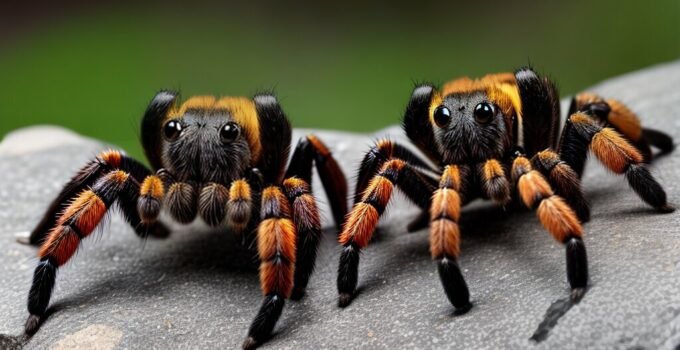For many, tarantulas might seem like a singular species, but there are actually different types of tarantulas that can be distinguished based on their location, physical characteristics, and behavior. Two of the most significant classifications are new world and old world tarantulas, which are separated based on their geographic origin. Differentiating between these two types of tarantulas is crucial for pet owners, enthusiasts, and researchers alike, as they have unique traits and behaviors.
In this comprehensive guide, we will take a closer look at new world and old world tarantulas and explore their distinguishing features. We will delve into their physical appearances, behaviors, and habitation differences, as well as their reproduction and lifespan variances. By the end of this article, you will have a better understanding of these fascinating arachnids and how to differentiate between them.
Key Takeaways:
New world and old world tarantulas are classified based on their geographic origin.
Distinguishing between these tarantula types is important for pet owners, enthusiasts, and researchers.
Physical appearance, behavior, habitation, and reproduction and lifespan variances are all crucial aspects to differentiate between new world and old world tarantulas.
Understanding Tarantula Classifications
Tarantulas are classified into two main groups: new world and old world. The division is based on the geographical origin of the species. New world tarantulas are found in the Americas, while old world tarantulas are found in Asia, Africa, and Europe.
The classification of tarantulas into new and old world is important in understanding their characteristics. New world tarantulas have unique features that distinguish them from old world tarantulas. For instance, new world tarantulas have urticating hairs, which are absent in old world tarantulas. These hairs are used for defense and can cause skin irritation, itching, and swelling if they come in contact with skin or eyes.
Old world tarantulas, on the other hand, have venom that is more potent and dangerous than that of new world tarantulas. They are also known to be more aggressive and have a higher tendency to burrow. Understanding these distinguishing characteristics is crucial for identifying and handling tarantulas safely and responsibly.
Geographical Distribution of New World Tarantulas
New world tarantulas are primarily found in the Americas, from Canada in the north to Argentina in the south. They are generally found in warmer and more humid regions, such as rainforests and deserts, and can be further classified based on their specific habitat preferences.
| Region | Example Species | Distinguishing Features |
|---|---|---|
| North America | Aphonopelma hentzi | Typically brown or black with short, thick hairs and a leg span of up to 6 inches. |
| Central America | Brachypelma vagans | Reddish-brown or black with a leg span of up to 5 inches and a distinctive black patch on the abdomen. |
| South America | Grammostola pulchra | Dark-colored with a leg span of up to 6 inches and a velvety appearance due to dense, short hairs. |
One of the key distinguishing features of new world tarantulas is the presence of urticating hairs, which they use for defense. These hairs are found on the abdomen and can be flicked off with their legs when threatened, causing irritation and itching to potential predators or humans. New world tarantulas also tend to have a more docile nature compared to their old world counterparts.
Given the diversity of new world tarantulas, it is crucial to understand their distinguishing features in order to properly identify and appreciate these fascinating creatures.
Geographical Distribution of Old World Tarantulas
Old World tarantulas are found primarily in regions such as Africa, Europe, and Asia. These species are known for their distinctive physical features and unique behaviors.
| Characteristic | Description |
|---|---|
| Size | Old World tarantulas are generally smaller than their New World counterparts, with some species measuring only a few inches in leg span. |
| Coloration | Old World tarantulas tend to have darker coloration, often with intricate patterns and markings. Some species display shades of blue and green. |
| Leg Span | The leg span of Old World tarantulas can be quite impressive, with some species reaching up to 12 inches. |
| Venom | Many Old World tarantulas possess venom that is more potent than that of New World species. Though not usually fatal to humans, bites can cause significant pain and discomfort. |
Old World tarantulas also have distinct behavioral traits. These spiders tend to be more aggressive than their New World counterparts and are known to be defensive when disturbed. As a result, they may bite more readily.
In addition to these distinguishing physical and behavioral characteristics, Old World tarantulas have unique habitat preferences. They are often found in dry, arid regions and can be burrowing spiders. Some species are arboreal and can be found living in trees or other tall vegetation.
Overall, understanding the characteristics that differentiate Old World tarantulas from New World species is crucial for identifying and appreciating these fascinating arachnids.
Physical Appearance of New World Tarantulas
New world tarantulas are known for their vibrant and striking physical appearance. They come in various sizes, ranging from small to medium, and have a leg span of four to six inches on average.
Their coloration is diverse, with some species sporting bright and contrasting patterns, while others showcase earthier tones. One common trait among new world tarantulas is the presence of urticating hairs, which they use as a defense mechanism. These hairs can cause severe irritation and inflammation when they come into contact with skin or eyes.
| Physical Feature | Description |
|---|---|
| Body Size | Small to medium-sized, typically four to six inches in leg span |
| Coloration | Diverse, ranging from bright and contrasting patterns to earthy tones |
| Urticating Hairs | Presence of irritant hairs used as a defense mechanism |
It is important to note that while some new world tarantulas may be visually similar, they can be differentiated based on their individual characteristics. A comprehensive understanding of their physical features can aid in identifying these unique and fascinating arachnids.
Physical Appearance of Old World Tarantulas
Old world tarantulas have distinct physical appearances that set them apart from their new world counterparts. They are generally smaller in size and possess a more streamlined body shape compared to new world tarantulas. Their leg span is typically shorter, and their coloration tends to be darker and less vivid.
One of the most notable features of old world tarantulas is their venomous fangs, which they use for both predation and defense. These fangs are larger and more potent than those of new world tarantulas, making them potentially more dangerous to humans.
Old world tarantulas lack the urticating hairs found on the abdomens of new world tarantulas. Instead, they have a different type of defense mechanism – when threatened, they may assume a defensive posture and raise their front legs, revealing the brightly colored underbelly. This is a warning to potential predators that the tarantula is not to be messed with.
Another distinguishing feature of old world tarantulas is their ability to climb smooth surfaces. They have specialized claws on their feet that allow them to climb trees and other vertical surfaces with ease.
| Physical Characteristics | Old World Tarantulas |
|---|---|
| Size | Generally smaller and more streamlined than new world tarantulas |
| Coloration | Darker and less vivid than new world tarantulas |
| Leg Span | Typically shorter than new world tarantulas |
| Fangs | Larger and more potent than those of new world tarantulas |
| Defense Mechanism | Raising front legs to reveal brightly colored underbelly |
| Climbing Ability | Specialized claws on feet allow for climbing of smooth surfaces |
Behavior and Habitat Differences
While the physical appearance of new world and old world tarantulas can provide significant clues for differentiation, their behavior and habitat preferences are also significant factors to consider.
| Behavior/Habitat | New World Tarantulas | Old World Tarantulas |
|---|---|---|
| Habitat preferences | New world tarantulas prefer warmer climates and are often found in the Americas, ranging from deserts to rainforests. | Old world tarantulas, on the other hand, prefer more diverse habitats such as forests and scrublands. They are native to regions such as Africa, Asia, and Europe. |
| Burrowing tendencies | New world tarantulas usually burrow in the ground as part of their natural habitat. | Old world tarantulas are more likely to reside in trees or rocks, and do not typically burrow as much as their new world counterparts. |
| Aggression levels | New world tarantulas tend to be more defensive and prone to aggression. When threatened, they may use their urticating hairs to ward off predators or become aggressive and deliver a painful bite. | Old world tarantulas typically exhibit less aggression, but some species are known to produce a more potent venom that can cause severe symptoms in humans. |
| Defense mechanisms | New world tarantulas are known for their ability to launch urticating hairs from their abdomens when threatened, causing irritation and discomfort. Some species can also deliver a painful bite if provoked. | Old world tarantulas tend to rely more on their venomous bites for defense, which can be more potent than that of their new world counterparts. |
Understanding the preferences and behaviors of new world and old world tarantulas can help differentiate between these two groups of arachnids. By examining their natural habitats and responses to threats, individuals can learn to identify and appreciate these fascinating creatures.
Reproduction and Lifespan Variances
Understanding the variations in reproduction and lifespan between new world and old world tarantulas is essential in differentiating between these two groups. While both have similar mating rituals, there are some differences in their egg sac production and lifespan.
| Tarantula Group | Mating Rituals | Egg Sac Production | Female Lifespan |
|---|---|---|---|
| New World Tarantulas | Male tarantulas perform a courtship dance to attract the female before mating. | Produce much larger and spherical egg sacs with several hundred spiderlings. | Can live for 10 to 20 years. |
| Old World Tarantulas | Male tarantulas use their pedipalps to transfer sperm into the female’s genital opening in a process called sperm induction. | Produce smaller, flat egg sacs with fewer spiderlings. | Have shorter lifespans, often living for only 5 to 10 years. |
It’s important to note that while these differences are generally true for these two groups, there can be variations within each species. Additionally, factors such as temperature, humidity, and diet can affect the lifespan and reproduction of individual tarantulas.
Conclusion
As we’ve seen, differentiating between new world and old world tarantulas is vital for anyone interested in these fascinating creatures. Understanding their physical appearance, behavior, habitat preferences, reproduction, and lifespan differences is crucial for anyone caring for them or studying them.
By learning to recognize the distinguishing features of these two groups of tarantulas, you’ll be able to appreciate their incredible diversity and understand the complexities of their ecosystems. Knowing how to identify new world and old world species will also come in useful when traveling to different parts of the world or when encountering tarantulas in the wild.
We hope that this guide has been helpful in providing a comprehensive and detailed overview of the differences between new world and old world tarantulas. By applying what you’ve learned, you’ll be able to confidently recognize and appreciate these incredible creatures.
FAQ
Q: What are the main differences between new world and old world tarantulas?
A: New world and old world tarantulas can be differentiated based on their geographic distribution, physical appearance, behavior, and reproductive traits.
Q: How are new world and old world tarantulas classified?
A: Tarantulas are classified as new world or old world based on their geographical origin. New world tarantulas are native to the Americas, while old world tarantulas are found in regions such as Africa, Europe, and Asia.
Q: What are the distinguishing features of new world tarantulas?
A: New world tarantulas are characterized by traits such as body size, coloration, leg span, and the presence of urticating hairs.
Q: What are the distinguishing features of old world tarantulas?
A: Old world tarantulas have distinguishing features such as size, coloration, leg span, and venomous attributes.
Q: How do new world and old world tarantulas differ in behavior and habitat?
A: New world and old world tarantulas exhibit differences in their habitat preferences, burrowing tendencies, aggression levels, and defense mechanisms.
Q: What are the variations in reproduction and lifespan between new world and old world tarantulas?
A: New world and old world tarantulas differ in aspects such as mating rituals, egg sac production, and female lifespan.



